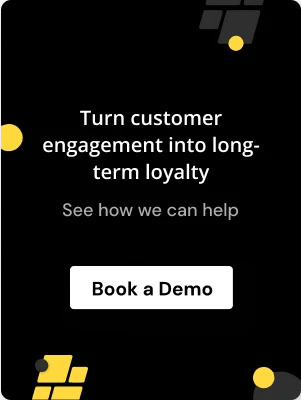.avif)
.avif)
Customers today don’t just buy products; they respond to experiences, consistency, and how a brand makes them feel. Whether it’s support, communication, or product discovery, people gravitate toward businesses that understand their needs. It’s why 80% of consumers prefer brands that personalize their experience, with many willing to spend up to 50% more when they feel genuinely understood.
Expectations have evolved, and so has the way customers choose who to stay loyal to. To meet those expectations, ecommerce businesses need more than good marketing. They need a clear way to engage customers at the right moments, with the right message, in a way that feels intentional.
That’s where customer engagement models come in. They outline how customers move through their journey, help you design meaningful touchpoints, and build relationships that last beyond a single purchase.
In this blog, we’ll break down 8 customer engagement models and how to choose the one that fits your business best.
Key Takeaways
- Customer engagement models provide structured ways to interact with customers throughout their journey, improving retention, satisfaction, and lifetime value.
- The engagement journey includes awareness, acquisition, onboarding, retention, and advocacy, each requiring tailored strategies to build strong relationships.
- Different models, such as High-Touch, Low-Touch, Hybrid, AARRR, and Customer Success Manager, serve distinct business needs depending on resources, scale, and goals.
- Automation, personalization, and data-driven insights are essential components to mainta-in effective engagement and ensure meaningful customer interactions.
- Selecting the right model requires understanding your audience, aligning with business objectives, utilizing the right technology, and continuously testing and refining strategies.
What is a Customer Engagement Model?
A customer engagement model is a framework that outlines how a business interacts with its customers throughout their journey, from the first point of contact to long-term loyalty. It focuses on creating meaningful and personalized interactions that keep customers engaged, satisfied, and loyal. This model helps businesses build stronger relationships, improve retention, and ultimately increase customer lifetime value.
Why It Matters:
Customer engagement models are important because they help ecommerce businesses:
- Build Strong Relationships: By engaging customers regularly, you create a deeper connection that goes beyond a single transaction.
- Increase Retention: A solid engagement model keeps customers coming back, reducing churn rates and encouraging repeat purchases.
- Drive Growth: Engaged customers are more likely to refer others, increasing your brand's reach and customer base.
- Enhance Customer Satisfaction: Personalized interactions make customers feel heard and understood, leading to higher satisfaction.
In short, a customer engagement model is the blueprint for how your business keeps customers happy, loyal, and coming back for more. Without it, businesses risk losing out on valuable relationships and revenue.
Also Read: 10 Best Customer Loyalty Software Platforms in 2026

5 Stages of the Customer Engagement Journey

The customer engagement journey involves several stages that guide prospects from first learning about your brand to becoming loyal advocates. Each stage is essential for nurturing lasting relationships and driving growth.
Stage 1: Awareness
Introduce your brand through clear, value-driven messaging that resonates with your audience’s needs and interests. It must help them recognize your business as a relevant solution.
Stage 2: Acquisition
Convert leads into customers by offering personalized, compelling offers that address their pain points. Showcase how your product or service meets their specific needs. Do you know personalized marketing strategies can reduce customer acquisition costs by up to 50%, while boosting revenue by 5–15%?
Stage 3: Onboarding
Provide a seamless experience from the first interaction, guiding customers through setup and ensuring they understand how to use your product to get the most value.
Stage 4: Retention
Engage customers with consistent, meaningful touchpoints such as newsletters, updates, and loyalty programs, reinforcing the value of your product and encouraging continued use.
Stage 5: Advocacy
Encourage satisfied customers to become brand advocates by offering incentives for referrals, reviews, and social sharing. This way, you can successfully turn them into promoters who bring in new business.
By learning these stages, you’ll build stronger customer relationships. Up next, we’ll explore some important customer engagement models that can help you excel in each stage of the journey.
8 Customer Engagement Models You Need to Know
Customer engagement models provide businesses with the strategies needed to build meaningful connections and long-term loyalty. Here are 8 models you can use to enhance customer interactions at every stage of their journey.

Model 1: High-Touch Engagement Model
The High-Touch Engagement Model involves providing personalized, one-on-one interactions with high-value customers. It focuses on deep, meaningful relationships by dedicating resources to give these customers exclusive support and attention.
For example, you can assign dedicated account managers to VIP clients, offering personalized shopping experiences and exclusive invites to events.
This model is highly useful for businesses with a smaller, high-value customer base, aiming for deep relationships. However, it requires significant resources and is only scalable for businesses with a smaller, high-value customer base.
Model 2: Low-Touch Engagement Model
The Low-Touch Engagement Model is designed for businesses with large customer bases, focusing on efficiency through automation. It provides essential interactions with minimal manual intervention, relying on self-service channels and automated communications.
For example, you may use automated email marketing campaigns to nurture customers, offering customer discounts and reminders based on their behavior. This automation drives engagement without significant resource allocation.
This model is highly useful for businesses looking to scale interactions while maintaining relevance without overwhelming their team. The main limitation here is its lack of personalization, which may lead to disengagement among customers seeking tailored experiences.
Model 3: Hybrid Engagement Model
The Hybrid Engagement Model blends high-touch and low-touch strategies, combining personalized interactions with automated processes. This model ensures that ecommerce businesses can engage a large number of customers while offering tailored experiences for high-value individuals.
For example, you can use automated emails for regular updates but provide dedicated support for top-tier customers, offering them customized selections based on preferences. This combination enhances both scalability and personalization.
This model is highly useful for businesses that want to balance efficiency with personal connections across their customer base. However, it requires careful balancing of automation and personalization, which can be complex and resource-intensive for mid-sized businesses.
Also Read: The Most Direct Cause of Customer Loyalty, Backed by 2025 Data
Model 4: AARRR (Pirate Metrics)
The AARRR model, also known as Pirate Metrics, focuses on five core metrics: Acquisition, Activation, Retention, Referral, and Revenue. It helps businesses track customer engagement at key stages and optimize strategies accordingly.
Here, you can track user signups (Acquisition), usage rates (Activation), and churn (Retention) to identify areas for improvement. By refining each metric, businesses can increase customer lifetime value and drive sustainable growth.
This model is highly useful for data-driven businesses focused on optimizing key performance metrics to enhance customer engagement. Still, relying primarily on data can overlook important user interactions that aren’t visible in quantitative reports.
Model 5: Customer Success Manager (CSM) Model
The CSM Model assigns dedicated account managers to customers to ensure they derive maximum value from the product or service. It focuses on proactive engagement to prevent churn and build long-term success.
For example, a software company can assign CSMs to monitor the health of customer accounts, providing training and guidance to ensure clients use the product to its full potential. This approach leads to higher satisfaction and reduced churn.
This model is highly useful for businesses with subscription-based services, aiming to drive customer success and reduce churn. However, note that this approach can be resource-intensive and costly, posing challenges for companies with extensive customer bases.
Model 6: Automated Retention Model
The Automated Retention Model uses automated tools to maintain engagement and drive customer retention. It focuses on using technology to send reminders, special offers, and personalized content based on customer behavior.
This model is highly useful for businesses aiming to maintain customer engagement with minimal manual effort. Nevertheless, without personalized touches, this model risks seeming impersonal and may struggle to maintain engagement.
But, with Nector's intuitive platform, you can enhance this approach by automating loyalty programs, sending personalized rewards like discounts on the next purchase, and driving repeat business. This minimizes manual effort and scales engagement effortlessly.
Model 7: Collaborative Product Roadmap Model
The Collaborative Product Roadmap Model engages customers by involving them in the product development process. It encourages feedback and collaboration, ensuring the product scales according to user needs.
For example, you may use customer feedback forums to let users vote on new features and suggest improvements. This makes customers feel valued and develop loyalty by aligning the product with their desires.
This model is highly useful for businesses that want to build community-driven engagement and create products that directly reflect customer input. Product development may be slowed under this model because responding to customer input can affect planning and priorities.
Model 8: USP Engagement Model
The USP Engagement Model centers around highlighting a brand’s Unique Selling Proposition (USP) to engage customers. It focuses on communicating what sets the brand apart from competitors, ensuring customers understand the distinct value they receive.
For example, a sustainable clothing brand may highlight its use of eco-friendly materials in all marketing and customer interactions, emphasizing its commitment to the environment. This unique messaging attracts customers who prioritize sustainability.
Highly effective in crowded markets, the USP engagement model helps brands differentiate through strong, value-driven messaging, but it can risk alienating customers who prefer more variety.
Each model discussed here offers unique benefits, but selecting the right one depends on your business goals and customer needs. Next, we’ll explore how to choose the best engagement model for your brand.
How to Choose the Right Customer Engagement Framework for Your Business?
Choosing the right customer engagement model is key to building lasting relationships and driving business growth. Focus on your audience, goals, and tools to make the best choice.

Step 1: Understand Your Audience
Know your customers’ preferences, behaviors, and needs. Tailoring your engagement model to their expectations ensures relevance and improves the chances of creating meaningful interactions.
Step 2: Match with Your Business Goals
Align the engagement model with your objectives. Whether you're aiming to boost retention, boost growth, or acquire new customers, choosing the right model supports these goals. For businesses aiming to scale while still maintaining relevance, Low-Touch or Hybrid Models provide a balance of automation and personalization.
Step 3: Consider Your Tech Stack
Make sure your current tools and platforms can support the chosen model. Integration with CRM, marketing automation, and analytics tools ensures smooth operations and efficient engagement. For businesses using automation tools, an Automated Retention Model can help you efficiently engage customers without the need for significant manual input.
Step 4: Set Clear Objectives
Define specific metrics like lifetime value or churn rate. These objectives help track progress, measure success, and refine your approach based on real data. If your business is data-driven, the AARRR (Pirate Metrics) model can help optimize key stages of the customer journey.
Step 5: Test & Iterate
Start small with a pilot program, test the model, and gather insights. Refine your approach based on results to ensure it effectively meets your engagement and retention goals.
By following these steps, you can choose the right model to drive engagement. Now, let’s explore how Nector can simplify and enhance your customer engagement efforts.
Also Read: How to Increase Repeat Customer Visits Using Loyalty Platforms

How Nector Can Help Drive Effective Customer Engagement?
Nector is the ideal solution for businesses looking to improve customer engagement. Our platform is simple, user-friendly, and designed to help you implement retention-driven models with ease. Whether you're starting from scratch or refining your strategy, Nector makes it easy to automate and personalize your customer interactions.
Here’s how Nector helps:
- Automated Loyalty Programs: Reward customers based on their actions with personalized incentives, perfect for retention-focused models.
- Behavior-Driven Engagement: Send tailored offers and reminders based on customer behavior, creating deeper connections and long-term loyalty.
- Easy Integration: Seamlessly connect with platforms like Shopify and your CRM tools to manage customer touchpoints.
- Clear Analytics: Track and refine your engagement models with actionable data, ensuring optimal performance.
Nector makes it easy to automate and personalize your retention strategies, enabling you to implement models that truly engage and retain your customers.
Final Thoughts
The customer engagement models, such as High-Touch, Low-Touch, AARRR, and Customer Success Manager, each offer distinct strategies to build deeper relationships and improve customer retention. By selecting the right model for your business, you can create personalized, automated, and scalable interactions that drive customer loyalty.
Nector simplifies this process by providing automated loyalty programs, behavior-driven engagement, and seamless integration with platforms like Shopify. Its intuitive features help you implement these models with ease, ensuring you focus on growing customer relationships.
Ready to strengthen customer engagement across every stage of the journey? Use Nector to automate loyalty, personalize retention efforts, and turn everyday interactions into long-term customer relationships.
FAQs
What are the best practices of customer engagement models?
Best practices include understanding customer needs, personalizing interactions, maintaining consistency across touchpoints, using automation effectively, and continuously measuring performance. Regular feedback and refining engagement strategies based on data ensure long-term loyalty.
What is the McKinsey customer engagement model?
The McKinsey customer engagement model focuses on delivering personalized, seamless customer experiences across all channels. It involves a deep understanding of customer needs, using data-driven insights to optimize interactions and building long-term relationships through consistent engagement.
What could a customer engagement model template look like?
A customer engagement model template outlines stages like awareness, acquisition, retention, and advocacy. It includes personalized strategies, automation tools, touchpoints, customer segmentation, and metrics to track success, ensuring engagement is consistent and relevant.
What is a customer engagement suite?
A customer engagement suite is a set of integrated tools and platforms designed to manage and optimize customer interactions across multiple channels. It includes features like email marketing, loyalty programs, chatbots, and analytics to enhance engagement.
Start Building Customer Retention That Lasts


%201.webp)






